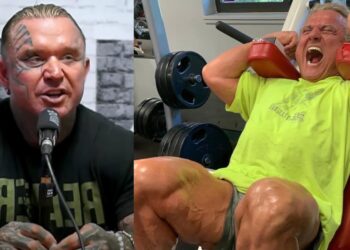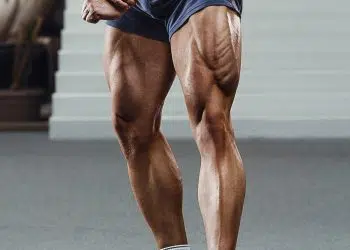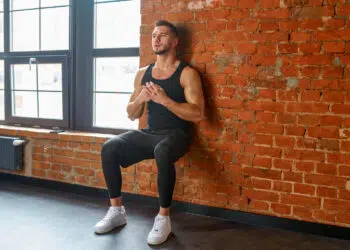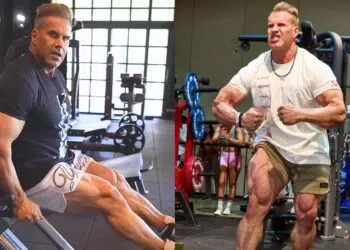Let’s get one thing straight from the start of this article: there ain’t nothing sissy about sissy squats! In fact, whether you do the freestanding version or use a sissy squat machine, this classic old-school exercise is a great quads builder, and it’s far from easy.
Even bodyweight sissy squats can be very humbling, especially if you’ve never done them before.
On the downside, sissy squats can be hard on your knees. If you have a pre-existing knee condition or knee pain, this exercise may not be suitable for you. Also, some people just find them awkward and don’t actually enjoy doing sissy squats.
Plus, as effective as sissy squats are, if you do them too often, they’ll start to lose some of their potency, so it’s a bad idea to rely on them too heavily.
The good news is that there are plenty of equally effective exercises you can do to target and develop your quads. In this article, we reveal the 12 best sissy squat alternatives!
Sissy Squats Muscles Worked
Sissy squats are a quadriceps exercise. So, to be considered a good alternative to sissy squats, any exercise you choose must also work the quads. But what are the quads, and what do they do? Keep reading to find out!
Level Up Your Fitness: Join our 💪 strong community in Fitness Volt Newsletter. Get daily inspiration, expert-backed workouts, nutrition tips, the latest in strength sports, and the support you need to reach your goals. Subscribe for free!
The term quadriceps refers to the fact that this body part comprises four individual muscles. The four quadriceps have separate origins or starting points and come together at a single insertion point called the quadriceps tendon.
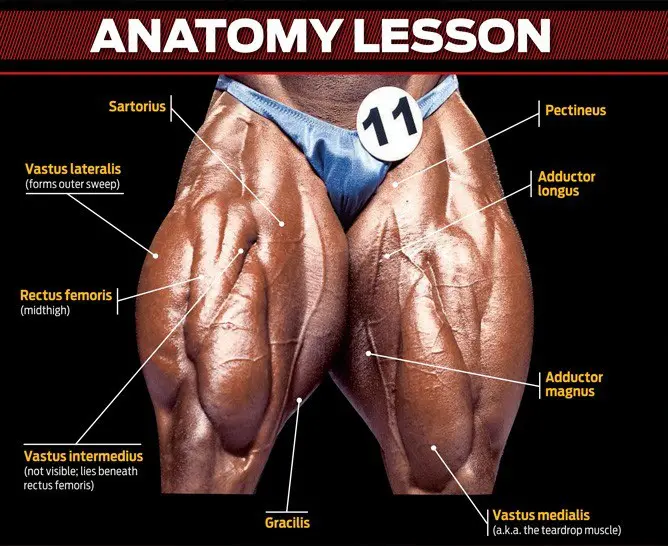
The four quadriceps are:
Rectus femoris
The rectus femoris is the longest of the quadriceps muscles. It’s also biaxial, meaning it crosses two joints – the knee and the hip. As such, the rectus femoris has two primary functions: knee extension and hip flexion.
Vastus medialis
Where rectus femoris is the longest quadriceps muscle, vastus medialis is the shortest. This muscle is located just above your knee and shaped like a teardrop. In fact, it’s often known as the teardrop quad. The vastus medialis is responsible for straightening the knee and is most active in the last few degrees of extension.
Vastus intermedius
Located between the vastus medialis and vastus lateralis, this long muscle really stands out at the front of your thighs. It’s a very powerful knee extensor and makes up much of the bulk of your anterior thighs.
Vastus lateralis
The vastus lateralis is the largest, strongest muscle in the quadriceps group. It’s located on the outside of your thigh and gives your quads their width. Well-developed vastus lateralis gives your thighs a pleasing shape, which is often called the quad sweep.
Top 12 Sissy Squat Alternatives
Are you bored of sissy squats? Or maybe they brother your knees? Don’t worry; there are plenty of exercises you can do instead.
Here are 12 of the best sissy squat alternatives for bigger, stronger quads:
- Leg extension machine
- Reverse Nordics
- Dumbbell leg extensions
- Cyclist squat
- Barbell hack squat
- Hack squat machine
- Smith machine sissy squat
- Front squat
- Narrow stance leg press
- Wall squat
- Short step lunge
- Straight leg raise
1. Leg extension machine
Sissy squats are basically a bodyweight leg extension. At least, they should be if you perform them correctly! Machine leg extensions isolate your quads, and unlike sissy squats, they allow you to train with loads lighter than your body weight.
https://youtu.be/Pv8geNtR3HM
Steps:
- Sit on your leg extension machine so your knees align with the lever arm pivot point. Adjust the backrest for comfort and support.
- Place your ankles behind the lower leg pad. Grip the handles by your sides.
- Smoothly extend your legs until your knees are straight. Do not kick the weight up, as doing so creates momentum and takes tension off your quads.
- Pause in the top position for 1-2 seconds.
- Bend your knees and lower the weights but do not let them touch to keep the tension on your quadriceps.
- Extend your legs and repeat.
Muscles targeted:
- Primary: Quadriceps
Benefits:
- Perfect for muscle-building drop sets.
- Widely available, as most gyms have a leg extension machine.
- Infinitely scalable, as you can go as light or as heavy as required.
Tips:
- Train one leg at a time to identify and fix any left-to-right strength imbalances.
- Pause at the top of each rep to increase time under tension.
- Pull your toes up toward your shins to increase quads activation.
2. Reverse Nordics
Reverse Nordics, also known as bodyweight leg extensions, are, like sissy squats, a calisthenic quadriceps isolation exercise. However, unlike sissy squats, you don’t have to lift your entire body weight to do them.
Steps:
- Kneel down so your body is upright and your knees, hips, and shoulders form a straight line. Press the tops of your feet into the floor. Your knees should be about hip-width apart.
- Cross your arms over your chest, brace your core, and engage your glutes.
- Keeping your body straight and only moving your knees, lean back as far as you can.
- Push your feet into the floor to return to the upright position.
- Continue for the desired number of reps.
Muscles targeted:
- Primary: Quadriceps.
- Secondary: Hip flexors, core.
Benefits:
- No equipment required.
- A very lower back-friendly exercise.
- Good for improving knee mobility as well as quadriceps strength.
Tips:
- Kneel on a folded gym mat or foam pad for comfort.
- Descend slowly and then come up a little quicker to maximize quadriceps engagement.
- Hold a weight plate across your chest to make this exercise more demanding. Attach a resistance band to an anchor in front of you and use it for assistance if reverse Nordic curls are too challenging, like this:
3. Dumbbell leg extensions
Machine leg extensions are one of the best alternatives to sissy squats for isolating your quads. But that’s no help if you train at home and don’t have the necessary equipment. Thankfully, you can also do leg extensions with a single dumbbell and a standard workout bench.
Steps:
- Sit on the end of an exercise bench with the backs of your knees pressed against the edge. Hold a dumbbell between your feet.
- Squeezing your feet and legs together, extend your legs until they’re straight.
- Bend your legs and repeat.
Muscles targeted:
- Primary: Quadriceps.
Benefits:
- A low-tech exercise that’s ideal for home exercisers.
- Scalable by using more or less weight as required.
- The strength curve means that this exercise is hardest as you reach terminal knee extension, which emphasizes the vastus medialis or teardrop quad.
Tips:
- Raise your bench on blocks to ensure you can get a full range of motion.
- Pause at the top of each rep and tense your quads for a more intense workout.
- Use a resistance band with or instead of a dumbbell for variety.
4. Cyclist squat
The cyclist squat, also known as the heels-elevated goblet squat, does not completely isolate your quads like sissy squats. However, lifting your heels pushes your knees forward so you can maintain a much more upright torso, which means your quads have to work far harder than they do during regular flat-heeled goblet squats.
Steps:
- Place two bumper weight plates on the floor about hip-width apart. Alternatively, use a length of wooden plank. Stand with your heels raised and the balls of your feet on the floor.
- Hold a kettlebell or dumbbell in front of your chest and just below your chin. Pull your shoulders down and back, and brace your core. Look straight ahead.
- Keeping your torso upright, bend your knees, and squat as deeply as you can without rounding your lower back.
- Stand up, stopping just short of locking your knees to keep the tension on your quads.
- Descend again and repeat for the required number of repetitions.
Muscles targeted:
- Primary: Quadriceps.
- Secondary: Hamstrings, gluteus maximus, core.
Benefits:
- A very quads-centric compound leg exercise.
- No squat rack required.
- A very safe exercise; drop the weight in front of you if you cannot complete a rep.
Tips:
- Do this exercise with a dumbbell if you don’t have access to kettlebells.
- Vary the height of your heel raise to see what works best for you.
- Use blood flow restriction cuffs to trigger a skin-splitting pump and make this exercise more challenging.
5. Barbell hack squat
The barbell hack squat is an old-school exercise predating the modern hack squat machine by almost a century. This exercise is named after strongman and wrestler George Hackenschmidt, who was famed for his muscular thighs, which he attributed to this effective, if somewhat awkward, leg exercise.
Steps:
- Stand with your back to the barbell, legs a little wider than hip-width apart, toes pointed slightly outward.
- Squat down and grab the barbell with a wider than shoulder-width grip.
- Keep your back straight, chest up, and core tight.
- Drive your feet into the floor and stand up, pulling the barbell up against the back of your legs.
- Bend your knees and lower the barbell to the ground.
- Repeat for the desired number of reps.
Muscles targeted:
- Primary: Quadriceps.
- Secondary: Hamstrings, gluteus maximus, core.
Benefits:
- A low-tech alternative to machine hack squats.
- A very safe exercise – no spotters or squat rack required.
- This exercise uses a large range of motion, which is good for developing mobility and flexibility.
Tips:
- Place your heels on raised blocks to increase quads engagement.
- Use a trap bar instead of a barbell for a more comfortable workout.
- Push your knees forward beyond your toes to increase quads engagement.
6. Hack squat machine
Machine hack squats are a lot more comfortable than the barbell variation. While this IS a compound exercise, fixing your hips in place means your quads are much more active than they are with regular squats and leg presses, which is why it’s made it onto our list of sissy squat alternatives.
Steps:
- Stand on the platform with your feet about hip-width apart, toes pointing forward. Put your shoulders under the pads and your back against the backrest. Extend your legs and release the weight safety catches.
- Bend your legs and squat down, allowing your knees to travel forward. Keep your back pressed into the backrest.
- Drive your feet into the floor and stand back up.
Muscles targeted:
- Primary: Quadriceps.
- Secondary: Hamstrings, gluteus maximus, core.
Benefits:
- A very accessible exercise – most gyms have a hack squat machine.
- Easy to learn and a good exercise for beginners.
- Very lower-back friendly.
Tips:
- Make this exercise even more of a quad-killer by rising up onto your toes as you descend.
- Keep your hips back and drive your knees forward to maximize quads engagement.
- Squeeze your quads at the top of each rep to make your workout more effective.
7. Smith machine sissy squat
Keeping your balance can be a real challenge during freestanding sissy squats. It’s also difficult to increase the resistance unless you hold a dumbbell in one hand, which tends to increase the load on one side of your body. Smith machine sissy squats fix both of these problems.
Steps:
- Stand under the Smith machine with the bar resting on your upper traps and not on your neck. Your feet should be no more than hip-width apart, toes pointing forward. Unrack the bar.
- Push your hips and knees forward and squat down as deep as you can. Lean against the bar and make sure your body remains straight.
- Drive the balls of your feet into the floor and push yourself back up.
Muscles targeted:
- Primary: Quadriceps.
- Secondary: Gluteus maximus, hamstrings.
Benefits:
- No balance required.
- You can train to failure in relative safety.
- Increase the load above and beyond your body weight for increased strength gains.
Tips:
- Place a folded towel between the bar and your upper back for comfort.
- Set the safety catches on the Smith machine to avoid descending too low.
- Contract your quads as hard as possible at the top of each rep to increase muscle engagement.
8. Front squat
While all types of squats work your quads and are a viable alternative for sissy squats, front squats are the most quad-dominant, so they’re arguably the best choice. Resting the bar on the front of your shoulders means you can keep your torso more upright and push your knees further forward, mimicking the demands of sissy squats more closely. However, front squats require more mobility and flexibility, so they may not be practical for everyone.
Steps:
- Put a barbell in your squat rack at about shoulder height.
- Walk forward and put your anterior (front) deltoids against the bar. Grip the bar with your hands just wider than shoulder-width apart.
- Push your elbows forward, and under the bar so your upper arms are parallel to the floor.
- Brace your core and pull your shoulders down and back. Unrack the bar and take 1-2 steps back.
- Set your feet between hip and shoulder-width apart.
- Bend your knees and hips at the same time. Descend as far as you can while keeping your torso upright, your elbows up, and your knees in line with your toes.
- Drive your feet into the floor and stand back up. Force your elbows upward as you ascend to stop the bar from rolling off your shoulders.
- Reset your core and repeat.
Muscles targeted:
- Primary: Quadriceps.
- Secondary: Gluteus maximus, hamstrings.
Benefits:
- An athletic, functional squatting exercise.
- Good for improving mobility and core strength.
- More lower back-friendly than barbell back squats.
Tips:
- Raise your heels on blocks to increase quads activation and squat deeper.
- Wear a weightlifting belt to increase lumbar stability and lift more weight.
- You can also do front squats using a Smith machine.
9. Narrow stance leg press
Leg presses are an excellent general leg exercise. However, if you move your feet closer together and a little lower on the footplate, this exercise emphasizes your quads and becomes a useful alternative to sissy squats.
Steps:
- Sit on the leg press and put your feet on the footplate so they are hip-width apart or closer.
- Extend your legs and flip the weight safety catches to the side.
- Bend your legs and lower the weight as far as possible without rounding your lower back or straining your knees.
- Push the weight back up and repeat.
Muscles targeted:
- Primary: Quadriceps.
- Secondary: Gluteus maximus, hamstrings.
Benefits:
- A very lower back-friendly exercise.
- An accessible exercise – most gyms have a leg press machine.
- A very straightforward movement, so ideal for beginners.
Tips:
- Do this exercise with one leg at a time to identify and fix any left-to-right strength imbalances, and strengthen your mind-muscle connection.
- Move your feet forward and backward on the footplate to find the most effective position for emphasizing your quads.
- Contract your quads as hard as possible at the top of each rep to make your workout more effective.
10. Wall squat
The wall squat, also known as the wall sit, is a very misunderstood exercise. Many people just lean on a wall in a squat position and hold it for as long as possible. This is both boring and ineffective. But, if you shake things up by pushing your back against the wall as hard as possible, you’ll quickly discover just how potent this exercise can be. So, long story short – push, don’t lean!
Level Up Your Fitness: Join our 💪 strong community in Fitness Volt Newsletter. Get daily inspiration, expert-backed workouts, nutrition tips, the latest in strength sports, and the support you need to reach your goals. Subscribe for free!
Steps:
- Lean your back against a wall and place your feet about two feet in front of you. Slide down the wall until your thighs are about parallel to the floor.
- Drive your feet forward and down, and push your lower back into the wall as hard as possible. Try to generate as much muscle tension as possible.
- Keep pushing for 10-30 seconds. If you think you can go for longer, you need to try harder!
Muscles targeted:
- Primary: Quadriceps.
- Secondary: Gluteus maximus, hamstrings.
Benefits:
- No equipment required – it’s the perfect excuse-free quads exercise.
- The harder you push, the more effective this exercise becomes, so it’s ideal for all levels of exerciser.
- A very knee and lower-back-friendly exercise.
Tips:
- Do this exercise before lunges, bodyweight squats, squat jumps, etc., for a much more intense bodyweight-only leg workout.
- Do wall squats on one leg for a more challenging quads workout.
- Adjust the height of your squat to target the quads from different angles. Going deeper than parallel will more closely mimic the feel and effect of sissy squats.
11. Short step lunge
Lunges share many benefits with squats. However, like squats, it is possible to make them more quads-centric, so they become a decent alternative to sissy squats. Simply taking a shorter step will put a lot more stress on your quads and provide your thighs with an incredible workout.
Steps:
- Stand with your feet together and your arms by your sides. Adopt a good posture and look straight ahead.
- Step forward about two feet, bend your legs and lower your rear knee down to the heel of your front leg.
- Push off your front leg and return to the starting position.
- Switch legs and repeat.
Muscles targeted:
- Primary: Quadriceps.
- Secondary: Gluteus maximus, hamstrings.
Benefits:
- A very functional quads-centric lower body exercise.
- Good for developing balance and mobility.
- Very lower-back friendly.
Tips:
- Make this exercise even more challenging by wearing a weighted vest or holding a dumbbell in each hand.
- Do short-step walking lunges for variety.
- Keep your torso upright to make sure your quads do more work than your glutes or hamstrings.
12. Straight leg raise
This quad-isolating sissy squat alternative works the three vastus muscles isometrically or statically, while the rectus femoris works isotonically to flex your hip. With no movement at the knee to worry about, this is a very joint-friendly quad exercise that’s often used in rehab and prehab situations.
How to do it:
- Sit on the floor with one leg bent and one leg straight. Place your hands behind you for balance and support, or lean your back against a wall.
- Contract the quadriceps of the straight leg and point your toe up toward the ceiling.
- Lift your straight leg as high as you can without slouching backward.
- Lower your leg and repeat.
- Do the same number of reps on both legs.
Muscles targeted:
- Primary: Quadriceps.
- Secondary: Hip flexors.
Benefits:
- No equipment required.
- Very knee joint and lower-back friendly.
- Train one leg at a time to identify and fix left-to-right strength imbalances.
Tips:
- Pause at the top of each rep for 2-3 seconds to make this exercise more demanding.
- Wear ankle weights for a more challenging workout.
- Sit on a bench or chair so you can lower and raise your leg through a larger range of motion.
Sissy Squat Alternatives FAQs
Do you have a question about sissy squats, sissy squat alternatives, or quads training in general? No worries – we’ve got the answers!
1. Are sissy squats bad for your knees?
Sissy squats are no worse for your knees than any other lower-body exercise, including leg extensions, regular squats, lunges, and leg presses. However, if they bother your knees, you should give them a miss and do one of the alternatives listed in this article. However, you should also avoid any exercise that causes joint pain.
2. How many times a week should I train my quads?
You can train your quads anywhere from once to 3-4 times per week (1). If you only train them once, you’ll need to do several exercises and sets of each to accumulate enough training volume. It’s generally agreed that muscles respond best to 10-20 sets per week.
However, if you decide to train your quads more often, you can do fewer exercises and sets per workout and still rack up a decent amount of volume.
Try low and high-frequency training approaches to see which one you prefer.
3. How many reps and sets should I do to build muscle?
Not so long ago, it was generally accepted that the best rep range for hypertrophy or building muscle was 6-12 reps. However, more recent research suggests you can do as many as 35+ reps and build muscle. This gives us a hypertrophy training range of roughly 6-35 reps per set.
However, the caveat is that you must take your sets close to failure for them to be effective.
Regarding sets, most experts believe you should do 10-20 sets per muscle group per week. This equates to 2-4 sets per exercise for most people.
4. How many reps should I do to build strength?
With hypotrophy, the aim of your workout is to exhaust the muscle. As such, you can use a wide range of loads and repetitions – from 6 to 35+.
However, to build strength, you need to use heavier weights, which will force you to do fewer reps. It’s generally accepted that you must train with weights greater than 85% of your one repetition maximum and stay in the 1-5 rep range to build strength.
That’s not to say you won’t get stronger lifting lighter loads for higher reps. However, low rep, heavy load training is arguably the most efficient way to increase maximal strength.
5. What should I eat to increase quadriceps mass?
It’s beyond the scope of this Q & A to provide you with a muscle-building diet. However, here are a few nutritional tips and a link to more of the information you need.
- Consume around one gram of protein per pound of body weight for muscle repair and growth. Good protein sources include meat, fish, eggs, dairy, nuts, seeds, and protein powder.
- Eat plenty of nutrient-dense whole foods and limit your intake of nutritionally-poor junk food.
- Create a 300-500 per day calorie surplus, so you’ve got plenty of energy for training, recovery, and muscle growth.
- Drink plenty of fresh water to stay hydrated.
- Use whey protein, creatine, amino acids, pre-workouts, and other supplements to maximize your training and enhance recovery.
6. Some of these exercises hurt my knees. What should I do?
Knee pain is a common problem that can be made worse by certain exercises and movements. If any of the exercises in this article bother your knees, you should drop them from your program and do the ones that don’t leave your joints inflamed and sore.
Also, make sure you are performing these exercises correctly, with appropriate loads, and not too often. In many cases, a lower training volume and a little less weight can alleviate many knee pain issues.
7. Do I have to train my legs?
You don’t have to do anything you don’t want to but skipping leg day would be a mistake. For starters, your lower body contain about 40 percent of your total body mass, and not training them will leave a lot of untapped, undeveloped muscle.
Also, a well-developed upper body paired with skinny legs just looks wrong and will have a negative impact on your aesthetics.
Unfortunately, leg training IS hard, which is why many exercisers don’t work their lower bodies as much as they should. However, nothing in life worth having comes easy, and a well-developed pair of legs shows that you are a dedicated hardcore lifter and others will respect your efforts.
More Alternative Exercises:
- The 13 Best Barbell Squat Alternatives
- Home Squat Alternatives for Strong, Sculpted Legs
- Smith Machine Squat Alternatives for Powerful, Muscular Legs
- Bulgarian Split Squat Alternatives for Stronger, More Athletic Legs
- Front Squat Alternatives for Mass, Strength, and Athletic Performance
- Hack Squat Alternative for Bigger, Stronger Legs
Wrapping Up
Love them or loath them, the sissy squat is an excellent quadriceps exercise. Think of them as a bodyweight alternative to leg extensions. However, that doesn’t mean you have to do them all the time or that you even need to do them at all if you don’t want to.
The good news is that there are plenty of equally effective quadriceps exercises you can perform instead. Use any of the 12 exercises listed above to develop the muscular, separated, strong quadriceps of your dreams!
References:
1- PubMed: How Many Times Per Week Should A Muscle Be Trained to Maximize Muscle Hypertrophy? https://pubmed.ncbi.nlm.nih.gov/30558493/
2- PubMed: Effects of different intensities of resistance training with equated volume load on muscle strength and hypertrophy https://pubmed.ncbi.nlm.nih.gov/29564973/
Interested in measuring your progress? Check out our strength standards for Smith Machine Squat, Bulgarian Split Squat, Bodyweight Squat, and more.



